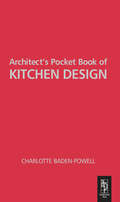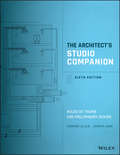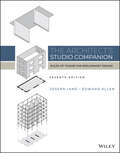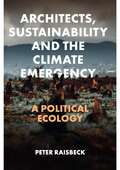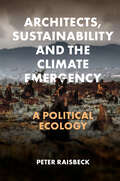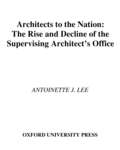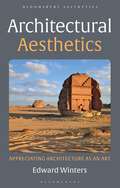- Table View
- List View
Architect's Pocket Book (Routledge Pocket Books)
by Jonathan Hetreed Ann Ross Charlotte Baden-PowellThis handy pocket book brings together a wealth of useful information that architects need on a daily basis – on-site or in the studio. It provides clear guidance and invaluable detail on a wide range of issues, from planning policy through environmental design to complying with Building Regulations, from structural and services matters to materials characteristics and detailing. This sixth edition includes the updating of regulations, standards and sources across a wide range of topics, with a particular focus on sustainability issues. Compact and easy to use, the Architect’s Pocket Book has sold well over 100,000 copies to the nation’s architects, architecture students, designers and construction professionals who do not have an architectural background but need to understand the basics, fast. This is the famous little blue book that you can’t afford to be without.
Architect's Pocket Book of Kitchen Design (Routledge Pocket Books)
by Charlotte Baden-PowellAs with the best-selling 'Architects Pocket Book' this title includes everyday information which the architect/designer normally has to find from a wide variety of sources and which is not always easily to hand.Focusing on kitchen design, this book is of use to the student as well as the experienced practitioner. It outlines all the information needed to design a workable kitchen, including ergonomics, services such as water and waste, appliances, and material choices for the floor, walls and ceiling. There is no similar compendium currently available.
Architect's Pocket Book of Kitchen Design (Routledge Pocket Books)
by Charlotte Baden-PowellAs with the best-selling 'Architects Pocket Book' this title includes everyday information which the architect/designer normally has to find from a wide variety of sources and which is not always easily to hand.Focusing on kitchen design, this book is of use to the student as well as the experienced practitioner. It outlines all the information needed to design a workable kitchen, including ergonomics, services such as water and waste, appliances, and material choices for the floor, walls and ceiling. There is no similar compendium currently available.
The Architect’s Pocket Guide to Portfolio Design
by Zuzana KubišováThis is an essential guide for architecture and design students struggling to put together an effective portfolio.There is too often a haphazard approach to architecture portfolio design and creation. Without a fundamental understanding of basic graphic design principles, portfolios can seem garish and disjointed, doing a disservice to the work on show and the designers’ professional potential. This concise and highly visual guide explains the fundamental principles of portfolio creation, provides dos and don’ts, common mistakes, and analysis of a diverse range of both successful and unsuccessful samples. Aspirational, innovative design work is also presented alongside detailed commentary breaking down the reasons why it works. Chapters walk through the complete process in an intuitive way, covering purpose, curation, form, layout, content and review, while providing both digital and print techniques.Following the framework laid out in this book will quickly and effectively elevate any architecture portfolio, allowing you to showcase your work in the most professional way possible.
The Architect’s Pocket Guide to Portfolio Design
by Zuzana KubišováThis is an essential guide for architecture and design students struggling to put together an effective portfolio.There is too often a haphazard approach to architecture portfolio design and creation. Without a fundamental understanding of basic graphic design principles, portfolios can seem garish and disjointed, doing a disservice to the work on show and the designers’ professional potential. This concise and highly visual guide explains the fundamental principles of portfolio creation, provides dos and don’ts, common mistakes, and analysis of a diverse range of both successful and unsuccessful samples. Aspirational, innovative design work is also presented alongside detailed commentary breaking down the reasons why it works. Chapters walk through the complete process in an intuitive way, covering purpose, curation, form, layout, content and review, while providing both digital and print techniques.Following the framework laid out in this book will quickly and effectively elevate any architecture portfolio, allowing you to showcase your work in the most professional way possible.
Architects Sketches
by Kendra Schank SmithConcepts from architects’ minds evolve through sketches and as a mode of transference are conveyed to the finished building. This book compares qualities of sketches to reveal unique approaches to the instruments of thinking in which all architects engage. It provides new insight into the relationship between architectural sketches and the process of creative manipulation. Sketches comprise a thinking mechanism, and through the qualities of ambiguity, quickness and change, they initiate a dialogue for architects. As a medium to facilitate communication, recording, discovery and evaluation, their pertinence lies in their ability to exhibit both the precise and the imprecise. Exploring four related theoretical approaches, play, memory-imagination-fantasy, caricature and the grotesque, the book shows how imprecision stimulates imagination to conceive new forms in the dialogue of architectural sketches.
Architects Sketches
by Kendra Schank SmithConcepts from architects’ minds evolve through sketches and as a mode of transference are conveyed to the finished building. This book compares qualities of sketches to reveal unique approaches to the instruments of thinking in which all architects engage. It provides new insight into the relationship between architectural sketches and the process of creative manipulation. Sketches comprise a thinking mechanism, and through the qualities of ambiguity, quickness and change, they initiate a dialogue for architects. As a medium to facilitate communication, recording, discovery and evaluation, their pertinence lies in their ability to exhibit both the precise and the imprecise. Exploring four related theoretical approaches, play, memory-imagination-fantasy, caricature and the grotesque, the book shows how imprecision stimulates imagination to conceive new forms in the dialogue of architectural sketches.
The Architect's Studio Companion: Rules of Thumb for Preliminary Design
by Edward Allen Joseph IanoThe time-saving resource every architect needs The Architect’s Studio Companion is a robust, user-friendly resource that keeps important information at your fingertips throughout the design process. It includes guidelines for the design of structure, environmental systems, parking, accessibility, and more. This new sixth edition has been fully updated with the latest model building codes for the U.S. and Canada, extensive new information on heating and cooling systems for buildings, and new structural systems, all in a form that facilitates rapid preliminary design. More than just a reference, this book is a true companion that no practicing architect or student should be without. This book provides quick access to guidelines for systems that affect the form and spatial organization of buildings and allows this information to be incorporated into the earliest stages of building design. With it you can: Select, configure, and size structural systems Plan for building heating and cooling Incorporate passive systems and daylighting into your design Design for parking and meet code-related life-safety and accessibility requirements Relying on straightforward diagrams and clear written explanations, the designer can lay out the fundamental systems of a building in a matter of minutes—without getting hung up on complicated technical concepts. By introducing building systems into the early stages of design, the need for later revisions or redesign is reduced, and projects stay on time and on budget. The Architect’s Studio Companion is the time-saving tool that helps you bring it all together from the beginning.
The Architect's Studio Companion: Rules of Thumb for Preliminary Design
by Edward Allen Joseph IanoThe time-saving resource every architect needs The Architect’s Studio Companion is a robust, user-friendly resource that keeps important information at your fingertips throughout the design process. It includes guidelines for the design of structure, environmental systems, parking, accessibility, and more. This new sixth edition has been fully updated with the latest model building codes for the U.S. and Canada, extensive new information on heating and cooling systems for buildings, and new structural systems, all in a form that facilitates rapid preliminary design. More than just a reference, this book is a true companion that no practicing architect or student should be without. This book provides quick access to guidelines for systems that affect the form and spatial organization of buildings and allows this information to be incorporated into the earliest stages of building design. With it you can: Select, configure, and size structural systems Plan for building heating and cooling Incorporate passive systems and daylighting into your design Design for parking and meet code-related life-safety and accessibility requirements Relying on straightforward diagrams and clear written explanations, the designer can lay out the fundamental systems of a building in a matter of minutes—without getting hung up on complicated technical concepts. By introducing building systems into the early stages of design, the need for later revisions or redesign is reduced, and projects stay on time and on budget. The Architect’s Studio Companion is the time-saving tool that helps you bring it all together from the beginning.
The Architect's Studio Companion: Rules of Thumb for Preliminary Design
by Joseph Iano Edward AllenTHE ARCHITECT’S STUDIO COMPANION The latest edition of the guidebook every architect needs at their fingertips, updated and expanded throughout Start your designs on solid ground with The Architect’s Studio Companion! This comprehensive handbook provides everything you need for the preliminary selecting, configuring, and sizing of the structural, environmental, safety, accessibility, and parking systems of a building. Edward Allen and Joseph Iano, authors of the market-leading Fundamentals of Building Construction, use their trademark talent for boiling down complex technical requirements into easy-to-use, time-saving guidelines for the engineering and architectural design of buildings. The new seventh edition is updated with new building codes, new information on heating and cooling systems for buildings, new structural systems, new requirements for tall mass timber buildings, and more. Throughout the text, straightforward diagrams and user-friendly explanations help you lay out the most important systems of a building in a matter of minutes without stressing about complicated technical concepts. Use this guide to introduce building systems into the early stages of design, and greatly reduce the need for later revisions or redesign???and keep your projects on time and on budget. Streamline your design process today with The Architect’s Studio Companion: Explore alternative structural systems quickly and efficiently Compare the carbon impacts of alternative system choices… at a glance Stay current with the latest information about tall mass timber buildings Access information on high-performance heating and cooling systems, passive design, natural daylighting, and other sustainable design strategies with ease Incorporate U.S. and Canadian building code requirements and accessibility regulations into your designs More than just a reference, The Architect’s Studio Companion, Seventh Edition is a must-have companion that no practicing architect or student should be without.
The Architect's Studio Companion: Rules of Thumb for Preliminary Design
by Joseph Iano Edward AllenTHE ARCHITECT’S STUDIO COMPANION The latest edition of the guidebook every architect needs at their fingertips, updated and expanded throughout Start your designs on solid ground with The Architect’s Studio Companion! This comprehensive handbook provides everything you need for the preliminary selecting, configuring, and sizing of the structural, environmental, safety, accessibility, and parking systems of a building. Edward Allen and Joseph Iano, authors of the market-leading Fundamentals of Building Construction, use their trademark talent for boiling down complex technical requirements into easy-to-use, time-saving guidelines for the engineering and architectural design of buildings. The new seventh edition is updated with new building codes, new information on heating and cooling systems for buildings, new structural systems, new requirements for tall mass timber buildings, and more. Throughout the text, straightforward diagrams and user-friendly explanations help you lay out the most important systems of a building in a matter of minutes without stressing about complicated technical concepts. Use this guide to introduce building systems into the early stages of design, and greatly reduce the need for later revisions or redesign???and keep your projects on time and on budget. Streamline your design process today with The Architect’s Studio Companion: Explore alternative structural systems quickly and efficiently Compare the carbon impacts of alternative system choices… at a glance Stay current with the latest information about tall mass timber buildings Access information on high-performance heating and cooling systems, passive design, natural daylighting, and other sustainable design strategies with ease Incorporate U.S. and Canadian building code requirements and accessibility regulations into your designs More than just a reference, The Architect’s Studio Companion, Seventh Edition is a must-have companion that no practicing architect or student should be without.
Architects, Sustainability and the Climate Emergency: A Political Ecology
by Peter RaisbeckThe promises, dreams and hopes of architects for future cities are now inextricably linked to climate change. Architects, Sustainability and the Climate Emergency: A Political Ecology chronicles how architects have shaped their ideas of the city—and sustainability—as knowledge of the climate emergency has unfolded. Have architects responded to the climate crisis too slowly? Describing a political ecology of architecture, Peter Raisbeck draws on architectural history, theory and practice, and the climate imaginaries of architects themselves. This exploration indicates how architects have viewed the climate emergency and positions architecture alongside the politics of climate and development studies. Raisbeck questions to what degree the traditional agency of architects leads to a political authority isolated from nature, human-environment systems and the nonhuman ecological subjects rapidly approaching tipping points. The fluidity of the climate emergency itself and its unfolding relationship to architectural knowledge suggests that new approaches, agencies and subjectivities are urgently required. As architects struggle to respond to the climate emergency, this book is an important and timely contribution to sustainability, climate and development debates. Architects, Sustainability and the Climate Emergency: A Political Ecology is a necessary provocation of a critical topic.
Architects, Sustainability and the Climate Emergency: A Political Ecology
by Peter RaisbeckThe promises, dreams and hopes of architects for future cities are now inextricably linked to climate change. Architects, Sustainability and the Climate Emergency: A Political Ecology chronicles how architects have shaped their ideas of the city—and sustainability—as knowledge of the climate emergency has unfolded. Have architects responded to the climate crisis too slowly? Describing a political ecology of architecture, Peter Raisbeck draws on architectural history, theory and practice, and the climate imaginaries of architects themselves. This exploration indicates how architects have viewed the climate emergency and positions architecture alongside the politics of climate and development studies. Raisbeck questions to what degree the traditional agency of architects leads to a political authority isolated from nature, human-environment systems and the nonhuman ecological subjects rapidly approaching tipping points. The fluidity of the climate emergency itself and its unfolding relationship to architectural knowledge suggests that new approaches, agencies and subjectivities are urgently required. As architects struggle to respond to the climate emergency, this book is an important and timely contribution to sustainability, climate and development debates. Architects, Sustainability and the Climate Emergency: A Political Ecology is a necessary provocation of a critical topic.
Architects to the Nation: The Rise and Decline of the Supervising Architect's Office
by Antoinette J. LeeThis unique book traces the evolution and accomplishments of the office that from 1852 until 1939 held a virtual monopoly over federal building design. Among its more memorable buildings are the Italianate U.S. Mint in Carson City, the huge granite pile of the State, War, and Navy Building in Washington, D.C., the towering U.S. Post Office in Nashville, New York City's neo-Renaissance customhouse, and such "restorations" as the ancient adobe Palace of the Governors in Santa Fe. In tracing the evolution of the Office and its creative output, Antoinette J. Lee evokes the nation's considerable efforts to achieve an appropriate civic architecture.
Architects Without Frontiers
by Esther CharlesworthFrom the targeted demolition of Mostar’s Stari-Most Bridge in 1993 to the physical and social havoc caused by the 2004 Boxing Day Tsunami, the history of cities is often a history of destruction and reconstruction. But what political and aesthetic criteria should guide us in the rebuilding of cities devastated by war and natural calamities? The title of this timely and inspiring new book, Architects Without Frontiers, points to the potential for architects to play important roles in post-war relief and reconstruction. By working “sans frontières”, Charlesworth suggests that architects and design professionals have a significant opportunity to assist peace-making and reconstruction efforts in the period immediately after conflict or disaster, when much of the housing, hospital, educational, transport, civic and business infrastructure has been destroyed or badly damaged. Through selected case studies, Charlesworth examines the role of architects, planners, urban designers and landscape architects in three cities following conflict - Beirut, Nicosia and Mostar - three cities where the mental and physical scars of violent conflict still remain. This book expands the traditional role of the architect from 'hero' to 'peacemaker' and discusses how design educators can stretch their wings to encompass the proliferating agendas and sites of civil unrest.
Architects Without Frontiers
by Esther CharlesworthFrom the targeted demolition of Mostar’s Stari-Most Bridge in 1993 to the physical and social havoc caused by the 2004 Boxing Day Tsunami, the history of cities is often a history of destruction and reconstruction. But what political and aesthetic criteria should guide us in the rebuilding of cities devastated by war and natural calamities? The title of this timely and inspiring new book, Architects Without Frontiers, points to the potential for architects to play important roles in post-war relief and reconstruction. By working “sans frontières”, Charlesworth suggests that architects and design professionals have a significant opportunity to assist peace-making and reconstruction efforts in the period immediately after conflict or disaster, when much of the housing, hospital, educational, transport, civic and business infrastructure has been destroyed or badly damaged. Through selected case studies, Charlesworth examines the role of architects, planners, urban designers and landscape architects in three cities following conflict - Beirut, Nicosia and Mostar - three cities where the mental and physical scars of violent conflict still remain. This book expands the traditional role of the architect from 'hero' to 'peacemaker' and discusses how design educators can stretch their wings to encompass the proliferating agendas and sites of civil unrest.
Architectural Acoustics (PocketArchitecture)
by Ana M Jaramillo Chris SteelThe application of good acoustic design can seem daunting to designers when trying to understand the often-complex physics of sound control. The ever-increasing number of standards and performance criteria that can be requested on new developments further complicates acoustics for architects. Architectural Acoustics, part of the PocketArchitecture series, provides the fundamental theory and understanding of acoustics and applications of effective detailing for specific building types and conditions in an accessible and clear technical guide. The book provides: a compact and understandable introduction to the fundamentals of building and architectural acoustics definitions of suitable acoustic performance criteria for a wide range of common buildings and room types guidance on specification and detailing of the most suitable construction types in North America and the UK. This book is both, a handy rule of thumb on acoustics for anyone involved in the design or construction of buildings, as well as an essential addition to any architect’s reference library.
Architectural Acoustics (PocketArchitecture)
by Ana M Jaramillo Chris SteelThe application of good acoustic design can seem daunting to designers when trying to understand the often-complex physics of sound control. The ever-increasing number of standards and performance criteria that can be requested on new developments further complicates acoustics for architects. Architectural Acoustics, part of the PocketArchitecture series, provides the fundamental theory and understanding of acoustics and applications of effective detailing for specific building types and conditions in an accessible and clear technical guide. The book provides: a compact and understandable introduction to the fundamentals of building and architectural acoustics definitions of suitable acoustic performance criteria for a wide range of common buildings and room types guidance on specification and detailing of the most suitable construction types in North America and the UK. This book is both, a handy rule of thumb on acoustics for anyone involved in the design or construction of buildings, as well as an essential addition to any architect’s reference library.
Architectural Acoustics: A guide to integrated thinking
by Raj PatelThis book is an authoritative but uniquely accessible and highly illustrated guide to good acoustic design practice for architects, interior designers and acoustic professionals. It provides a user-friendly introduction to architectural acoustics and acoustics technology where the market is crowded with dense and technical texts. It will go through each typology in turn explaining the key acoustic concepts with highly illustrated and international case studies that demonstrate cutting-edge practice and technology, innovative design techniques and common challenges and solutions.
Architectural Acoustics: A guide to integrated thinking
by Raj PatelThis book is an authoritative but uniquely accessible and highly illustrated guide to good acoustic design practice for architects, interior designers and acoustic professionals. It provides a user-friendly introduction to architectural acoustics and acoustics technology where the market is crowded with dense and technical texts. It will go through each typology in turn explaining the key acoustic concepts with highly illustrated and international case studies that demonstrate cutting-edge practice and technology, innovative design techniques and common challenges and solutions.
Architectural Acoustics Illustrated
by Michael ErmannUnite the science of sound and the principles of design to enhance any space Architectural Acoustics Illustrated translates the quantitative and qualitative content of acoustics into the graphic language of architecture. This highly-visual guide includes over 350 illustrations that outline the physics of sound and the best design practices for limiting or mitigating noise in buildings by using the latest in materials and techniques. Each chapter includes a summary checklist of design guidelines to help prevent mistakes and oversights, and the Instructor's website offers video animations demonstrating acoustical concepts. Designed as a "first look" at the interaction of sound and space, the book explains the principles of architectural acoustics and their practical applications, providing a comprehensive guide for designing with acoustics in mind. Architectural acoustics is more than just concert halls – it may determine building placement, division of interior space, exterior construction, and even siting. When addressed early in the design process, the resulting space can be free of unwanted sound and promote good hearing; if left unaddressed, the problems with the space can lead to lawsuits and costly post-construction remediation. Architectural Acoustics Illustrated helps designers solve most acoustical problems in advance, by enabling readers to: Understand the physical science underlying the behavior of sound Consider the interactions of sound and space in the initial design approach Mitigate building sounds such as those produced by HVAC and plumbing with early design planning Design spaces for listening, and incorporate acoustics best practices into every plan The highly visual format of the book helps readers grasp complex concepts quickly, and thorough discussion of each concept's real-world application ties the science directly into the design process. All design professionals need to have a fundamental understanding of acoustics, and Architectural Acoustics Illustrated is a comprehensive, practical guide in an easy-to-read format.
Architectural Acoustics Illustrated
by Michael ErmannUnite the science of sound and the principles of design to enhance any space Architectural Acoustics Illustrated translates the quantitative and qualitative content of acoustics into the graphic language of architecture. This highly-visual guide includes over 350 illustrations that outline the physics of sound and the best design practices for limiting or mitigating noise in buildings by using the latest in materials and techniques. Each chapter includes a summary checklist of design guidelines to help prevent mistakes and oversights, and the Instructor's website offers video animations demonstrating acoustical concepts. Designed as a "first look" at the interaction of sound and space, the book explains the principles of architectural acoustics and their practical applications, providing a comprehensive guide for designing with acoustics in mind. Architectural acoustics is more than just concert halls – it may determine building placement, division of interior space, exterior construction, and even siting. When addressed early in the design process, the resulting space can be free of unwanted sound and promote good hearing; if left unaddressed, the problems with the space can lead to lawsuits and costly post-construction remediation. Architectural Acoustics Illustrated helps designers solve most acoustical problems in advance, by enabling readers to: Understand the physical science underlying the behavior of sound Consider the interactions of sound and space in the initial design approach Mitigate building sounds such as those produced by HVAC and plumbing with early design planning Design spaces for listening, and incorporate acoustics best practices into every plan The highly visual format of the book helps readers grasp complex concepts quickly, and thorough discussion of each concept's real-world application ties the science directly into the design process. All design professionals need to have a fundamental understanding of acoustics, and Architectural Acoustics Illustrated is a comprehensive, practical guide in an easy-to-read format.
Architectural Aesthetics: Appreciating Architecture As An Art (Bloomsbury Aesthetics)
by Edward WintersThe fine arts are traditionally seen to have intrinsic value: that is, they are valuable in themselves. But this poses a problem for architecture: its works are designed to serve our purposes, and therefore it is classed as functional. Carving out a new space, Edward Winters argues why architecture is a fine art and finds a place for the fine art of architecture in the cultural environment in which we structure our lives.Winters reconciles intrinsic value, as a fine art, with extrinsic value, as shelter, security and comfort, without collapsing into the modernist conception of Functionalism. He draws on the Apollonian and the Dionysian to resolve the apparent conflict between the two values: the former requiring contemplative, detached reflection, the latter an engaged, embodied entanglement with the festive mood inspired by the immediate situation. Architecture, Winters claims, is to be regarded as functional; but this functionality is subsumed under the intrinsic aesthetic value of living well. Introducing the main positions in the philosophy of architecture through the lens of the timeless argument about what constitutes art, Winters lays out a humanistic view of the medium and extends our understanding of aesthetics and the everyday.
Architectural Aesthetics: Appreciating Architecture As An Art (Bloomsbury Aesthetics)
by Edward WintersThe fine arts are traditionally seen to have intrinsic value: that is, they are valuable in themselves. But this poses a problem for architecture: its works are designed to serve our purposes, and therefore it is classed as functional. Carving out a new space, Edward Winters argues why architecture is a fine art and finds a place for the fine art of architecture in the cultural environment in which we structure our lives.Winters reconciles intrinsic value, as a fine art, with extrinsic value, as shelter, security and comfort, without collapsing into the modernist conception of Functionalism. He draws on the Apollonian and the Dionysian to resolve the apparent conflict between the two values: the former requiring contemplative, detached reflection, the latter an engaged, embodied entanglement with the festive mood inspired by the immediate situation. Architecture, Winters claims, is to be regarded as functional; but this functionality is subsumed under the intrinsic aesthetic value of living well. Introducing the main positions in the philosophy of architecture through the lens of the timeless argument about what constitutes art, Winters lays out a humanistic view of the medium and extends our understanding of aesthetics and the everyday.
Architectural Anthropology: Exploring Lived Space (Routledge Research in Architecture)
by Marie StenderThis book prompts architects and anthropologists to think and act together. In order to fully grasp the relationship between human beings and their built environments and design more livable and sustainable buildings and cities in the future, we need new cross-disciplinary approaches combining anthropology and architecture. This is neither anthropology of architecture, nor ethnography for architects, but a new approach beyond these positions: Architectural Anthropology. The anthology gathers contributions from leading researchers from various Nordic universities, architectural schools, and architectural firms as well as prominent international scholars like Tim Ingold, Albena Yaneva, and Sarah Pink – all exploring, developing, and innovating the cross-disciplinary field between anthropology and architecture. Several contributions are co-written by architects and anthropologists, merging approaches from the two disciplines in order to fully explore the dynamics of lived space. Through a broad range of empirical examples, methodological approaches, and theoretical reflections, the anthology provides inspiration and tools for scholars, students, and practitioners working with lived space. The first part focusses on homes, walls, and boundaries, the second on urban space and public life, and the third on processes of creativity, participation, and design.

